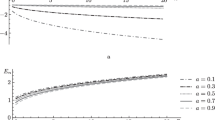Summary
The introduction of new classical hidden parameters to describe a possible internal extended structure of the Dirac electron is shown to provide a simple space-time topological interpretation of its 1/2 spin value. These variables also eliminate the usual «self-accelerated» runaway solutions of the Lorentz-Dirac electron and yield stable nonradiating internal oscillations which can explain the absence of observable classical external electromagnetic radiations in the case of Bohr-type orbits.
Riassunto
Si mostra che l'introduzione di nuovi parametri nascosti classici per la descrizione di una possibile struttura interna estesa dell'eletrone di Dirac fornisce una semplice interpretazione topologica per il valore 1/2 del suo spin. Queste variabili eliminano altresì le soluzioni autoaccelerate dell'elettrone di Lorentz-Dirac e dànno luogo a oscillazioni interne stabili e non irraggianti che possono spiegare, nel case delle orbite del tipo di Bohr, l'assenza di irraggiamento osservabile del campo elettromagnetico classico esterno.
Резюме
Показывается, что введение новых классических скрытых параметров для описания возможной внутренней протяженной структуры дираковского электрона обеспечивает простую пространственно-временную топологическую интерпретацию величины спина 1/2 электрона. Эти переменные также исключают обычные «самоускоряющиеся» решения для электрона Лорентца-Дирака и приводят к устойчивым неизлучающим внутренним осцилляциям, которые могут обБяснить отсутствие наблюдаемого классического внешнего электромагнитного излучения в случае орбит боровского типа.
Similar content being viewed by others
References
J. P. Vigier:Compt. Rend.,279 B, 1 (1974).
D. Bohm andJ. P. Vigier:Phys. Rev.,109, 1882 (1958).
O. Hara andT. Goto:Prog. Theor. Phys.,33, 907 (1965).
W. Glaser:Zeits. Phys.,139, 276 (1954).
G. B. Cvijanovich: Habl. Thesis, University of Bern (1964);Classical electrodynamics with nonforce constitutive equations, preprint, Department, of Physics, Upsala College, East Orange, 1970;C. B. Coijanovich andJ. P. Vigier:Found. Phys., in press.
F. Halbwachs:Théorie relativiste des fluides à spin (Paris, 1960).
H. Poincaré:Compt. Rend.,140, 1504 (1905);Rend. Cir. Mat. Palermo,21, 129 (1906).
F. Rörlich:Classical Charged Particles (Reading, Mass., 1965).
J. V. Weyssenhof andA. Baabe:Acta Phys. Polon.,9, 8 (1947).
H. Yukawa:Phys. Rev.,77, 219 (1950);80, 1047 (1950).
A. Sommerfeld:Nachr. Akad. Wiss. Goettingen, Math. Physik Kl. IIa, Math. Physik Chem. Abt., 99 and 363 (1904); 201 (1905).
G. Herglotz:Nachr. Akad Wiss. Goettingen, Math. Physik Kl. IIa, Math. Physik Chem. Abt., 357 (1903);Math. Ann.,65, 87 (1908).
P. Hertz:Math. Ann.,65, 1 (1908).
S. R. Milner:Phil. Mag.,41, 405 (1921).
G. A. Schott:Phil. Mag.,752 (1933).
D. Bohm andM. Weinstein:Phys. Rev.,74, 1789 (1948).
G. H. Goedecke:Phys. Rev.,135, B 281 (1964).
A. Richoz:Helv. Phys. Acta,49, 99 (1976).
M. Born:Ann. der Phys.,30, 1 (1909).
J. R. Pounder:Communication of the Dublin Institute for Advanced Studies, A11 (1954).
L. Landau andE. Lifshitz:The Classical Theory of Fields (London), p. 218.
H. A. Lorentz:The Theory of Electrons (New York, N. Y.), p. 37.
P. A. M. Dirac:Proc. Roy. Soc., A167, 148 (1938).
M. Phillips:Handbuch der Physik, Band IV (Berlin), p. 82.
G. A. Schott:Proc. Roy. Soc., A159, 570 (1937).
F. Halbwachs, J. M. Souriau andJ. P. Vigier:Journ. Phys. Radium,22, 26 (1961).
F. Halbwachs:Compt. Rend.,249, 2293, 2500 (1959).
L. De Broglie: Thèse, Université de Paris (Paris, 1924).
A. Sommerfeld:Atombau und Spektrallinien, Vol.2 (Braunschweig, 1953).
L. de Broglie:Ondes electromagnétiques et photons (Paris, 1968).
L. de Broglie:Mécanique ondulatoire du photon et théorie quantique des champs (Paris, 1949).
M. Moles andJ. P. Vigier:Compt. Rend.,276 B, 697 (1973).
D. Bohm:Phys. Rev.,85, 166 (1952);89, 458 (1953).
L. de Broglie:La mécanique quantique restera-t-elle indéterministe? (Paris);Compt. Rend.,277 B, 71 (1973).
Author information
Authors and Affiliations
Additional information
Work partly supported by CNR, Contract No. 75.00422.02.
Переведено редакцией.
Rights and permissions
About this article
Cite this article
Gutkowski, D., Moles, M. & Vigier, JP. Hidden-parameter theory of the extended Dirac electron I: Classical theory. Nuovo Cim B 39, 193–225 (1977). https://doi.org/10.1007/BF02738189
Received:
Published:
Issue Date:
DOI: https://doi.org/10.1007/BF02738189



